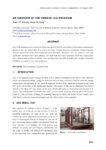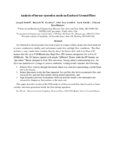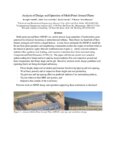TO
Filters: Collection: "ir_eua"
| Title | Date | Subject | Description | ||
|---|---|---|---|---|---|
| 201 |
 |
An evaluation of the extraction, transport and refining of imported crude oils and the impact on life cycle greenhouse gas emissions | 2009-03-27 | imported crude oils; life cycle of greenhouse gas emissions; greenhouse gas emissions; crude oil; GHG emissions | The National Energy Technology Laboratory (NETL) has analyzed the full life cycle greenhouse gas (GHG) emissions of transportation fuels derived from domestic crude oil and crude oil imported from specific countries. Estimates of the well-to-tank (WTT) GHG emissions associated with producing diesel ... |
| 202 |
 |
An evaluation of triple quadrupole ms/ms for on-line analyses of trace sulfur compounds from oil shale processing | 1985 | In order to effectively reduce sulfur gas content from shale processing to environmentally acceptable levels, H2S, COS, S02 and CH3SH plus trace sulfur compounds must be removed. Of these, the trace sulfur compounds have not been well characterized but should be known to ppm levels In order to optim... | |
| 203 |
 |
An experimental study on the thermal decomposition of catechol | 2002 | Thermal Decomposition; Catechol; Polycyclic aromatic hydrocarbons; PAH; Pyrolysis; ortho-dihydroxybenzene; Phenol decomposition; biomass; coal; wood; Kinetic model; Pyrolytic catechol decomposition; PAH formation and growth | In order to better elucidate the role of thermal decomposition products in the formation of polycyclic aromatic hydrocarbons (PAH) from complex fuels, we have performed pyrolysis experiments in a tubularflow reactor, using the model fuel catechol (ortho-dihydroxybenzene), a phenol-type compound repr... |
| 204 |
 |
An industrial development information system for Utah | 1969-12 | ||
| 205 |
 |
An overview of the Chinese UCG program | 2007-08-11 | Coal; China; Underground Coal Gasification; UCG; Two-stage gasification; Chinese UCG program; Energy | Coal is the dominant source of energy in China, but about 50% of the coal resource is left underground unmined. Because of this, the "long-tunnel, large section, two-stage" Underground Coal Gasification (UCG) technology has been put forward, and the UCG model platform has been built. Simulation test... |
| 206 |
 |
Analyses of oil extracted from oil-impregnated sandstone deposits in Utah | 1972-01 | This study, in progress from 1967 to 1970, is part of a systematic effort to find, map and sample Utah's oil-impregnated rock deposits. Samples were collected by ten individuals in field parties who examined oil-impregnated rock occurrences throughout the state. Samples 68-3A and 68-4A are from aban... | |
| 207 |
 |
Analysis of burner operation inside an enclosed ground flare | 2022 | Thermo-Acoustic Coupling; Enclosed Flare; LES CFD Model; Noise; Premixed Burner | An industrial enclosed ground flare used as part of a large refinery project has been analyzed to assess combustion stability and performance under low and high flow conditions. This flare includes a large combustion chamber directly above the burner deck with Low Flow (LF) burners that fire up to 9... |
| 208 |
 |
Analysis of crude shale oil | 1952-08 | A laboratory method for examining crude shale oil is described. The method uses only about 500 ml. of sample and a limited number of analytical determinations. Results provide information on the general characteristics and composition of an oil and serve as a basis for comparing different oils. Howe... | |
| 209 |
 |
Analysis of design and operation of multi-point ground flares | 2022 | Multi-point ground flares (MPGF) are used to process large quantities of hydrocarbon gases generated in chemical processing or petrochemical refining. These flares use hundreds of flare burners arranged and fired in a staged fashion. A wind fence surrounds the MPGF to shield the flames from plant op... | |
| 210 |
 |
Analysis of lacustrine deltaic sedimentation in the Green River Formation, southern Uinta Basin, Utah | 1991 | lacustrine deltaic sedimentation; Green River Formation; southern Uinta Basin; sedimentation analysis | Detailed lithofacies analysis of over 4,500 m of measured sections of most of the Eocene portion of the fluvial and lacustrine Green River Formation in the south-central Uinta Basin documents twelve lithofacies: Sa (nonsinuous trunk streams), Sb (meandering delta distributary channels), Sc (amalgama... |
| 211 |
 |
Analysis of oil shale and petroleum source rock pyrolysis by triple quadrupole mass spectrometry: Comparisons of gas evolution at the heating rate of 10 °C/min | 1990-10-05 | Kimmeridge; Phosphoria; La Luna; Teistberget; New Albany; Eastern U.S. Devonian; Janusfjellet; Wenzen; Maoming; Fushun; Woodford; Green River; Brotherson; Oil shale; Petroleum; Rock pyrolysis; Gas evolution; Programmed-temperature pyrolysis; Triple-quadrupole mass spectrometry; Mineral matrix; Miner... | Kimmeridge, Phosphoria, La Luna, Teistberget, New Albany, Janusfjellet, Wenzen, Maoming, Fushun, Woodford, and three Green River oil shales were subjected to programmed-temperature pyrolysis at a heating rate of 10 °C/min using triple-quadrupole mass spectrometry as the detection method. Volatile c... |
| 212 |
 |
Annual Report: University of Utah Staff Advisory Committee (UUSAC), 2013-2014 | 2014 | Annual report | Annual report of the University of Utah Staff Advisory Committee for the 2013-2014 fiscal year. The contents include the Development Committee, Legislative Committee, Events Committee, Communications & Selections Committee and the Executive Board & Committee Chairs. |
| 213 |
 |
Anxiety levels of psychiatric patients during hospitalization and at time of discharge. | 1964-06 | Mentally Ill; Anxiety | This study was made to determine (a) if there is a significant difference between anxiety levels of psychiatric patients at a midway point in their hospitalization and at the time of their discharge, and (b) is extra-hospital factors such as illness, employment status, or follow-up care influence an... |
| 214 |
 |
APECS software and architecture overview | 2009-10 | APECS; Model; CADE-OPEN; CO; CFD; PME; FLUENT; EKM; Reduced Order Models; ROMs; Geometric parameterization; Virtual reality software | 1) What is APECS? 2) Overview of APECS Features; 3) Overview of APECS Architecture |
| 215 |
 |
Apparatus and method for recovery of bituminous products from tar sands | 1978-06-20 | An apparatus and method for (1) reducing agglomerated masses of tar sand and (2) recovering as a bituminous product the bituminous matrix material therefrom. The apparatus includes a vessel which is divided into an attrition zone enclosed by a screen member, a sand separation zone and a product reco... | |
| 216 |
 |
Apparatus for extracting bitumen from tar sand | 1982-01-19 | Patent; Extracting bitumen from tar sand; Extraction chambers; Countercurrent flow; Plurality; Individually sealed pressure adjusted interconnected extraction chambers in series; Tar sand; Bitumen | A method and apparatus for extracting bitumen from tar sand utilizes a plurality of individually sealed pressure adjusted interconnected extraction chambers in which the tar sand flows countercurrent to the flow of solvent with mixing in each extraction chamber of solvent and tar sand. Tar sand is p... |
| 217 |
 |
Apparatus for separating organic material from particulate tar sands and coal and agglomeration of the particulate residue | 1976-10-05 | Patent; Tar sands; Coal; Agglomeration of particle residue; Agglomerating liquid; Immiscible; Varsol; Ball agglomerates | A rotatable drum having an interior which tapers in a horizontal direction has a first port at the smaller end for receiving particulate Tar Sands or coal, and an agglomerating liquid, e.g. water, and a second port at the larger end for receiving an organic material separating liquid, e.g. Varsol, w... |
| 218 |
 |
Apparatus for the treatment of tar sand froth | 1976-07-06 | Patent; Tar Sand Froth; Improved recycling disc-type centrifuge; Converting flow direction; Recycled underflow | An improved disc recycling type of centrifuge apparatus which includes means for converting the flow direction of the recycled underflow and causing the recycled underflow to self impact. |
| 219 |
 |
Appendix 1: User guide for characterizing particulate matter | 2003-09 | Air quality; Particulate matter; PM; Characterizing particulate matter; Sampling PM; PM background; Photoacoustic analyzer; PA; Photoelectric Aerosol Sensor; PAS; PAH; Aerosol time-of-flight mass spectrometer; ATOFMS; Dilution and Sampling; Soil; Dust; Smoke; Liquid droplets; Atmosphere; Nitrate; Su... | This User's Guide is intended to assist environmental or military personnel who work with air quality measurements, regulations, and planning for the Department of Defense. Specifically, it focuses on an evaluation of three newly developed instruments for characterizing particulate matter (PM), gene... |
| 220 |
 |
APPENDIX A - Analysis of environmental, legal, socioeconomic and policy issues critical to the development of commercial oil shale leasing on the public lands in Colorado, Utah and Wyoming under the mandates of the Energy Policy Act of 2005 - Final Project Report - Reporting period: June 21, 2006 to October 21, 2009 | 2009-10 | Oil shale; Colorado; Utah; Wyoming; Energy Policy Act of 2005; Green River Formation; Environmental; Legal; Socioeconomic; Policy Issues; Oil shale deposits; BLM; Bureau of Land Management | The United States is home to the largest oil shale deposits in the world. This resource is located in the Green River Formation, spreading across the states of Colorado, Utah and Wyoming. Despite the vast potential of this resource, successful commercial development has yet to occur. To date, concer... |
| 221 |
 |
APPENDIX B - Depositional heterogeneity and fluid flow modeling of the oil shale interval of the upper Green River Formation, eastern Uinta Basin, Utah - Final Project Report - Reporting period: June 21, 2006 to October 21, 2009 | 2009-10 | Green River Formation; Uinta Basin; Utah; Uintah County; Oil shale; Deposition | In this project, a detailed geological analysis was performed followed by a reservoir modeling exercise. For the geological analysis, ~300 m of cores were correlated to gamma and density logs in well P4 in the lower to middle Eocene (49.5-48.0 million years ago (Ma)), upper Green River Formation of ... |
| 222 |
 |
APPENDIX C - In-situ production of Utah oil sands - Final Project Report - Reporting period: June 21, 2006 to October 21, 2009 | 2009-10 | Utah; Uinta Basin; Oil sand reservoirs; Whiterocks; Sunnyside; Oil; Oil extraction; In-situ; Heavy oil production; Bitumen | Two oil sand reservoirs located in Utah's Uinta Basin were considered for analysis: Whiterocks, a small, steeply dipping, contained reservoir containing about 100 million barrels, and Sunnyside, a giant reservoir containing over four billion barrels of oil in place. Cyclic steam stimulation, steam a... |
| 223 |
 |
APPENDIX D - Meeting data needs to perform a water impact assessment for oil shale development in the Uinta and Piceance Basins, A subpart of project - Quantifying water availability impacts and protecting water quality while developing Utah oil shale and sands - Final Project Report - Reporting period: June 21, 2006 to October 21, 2009 | 2009-06-23 | Uinta Basin; Piceance Basins; Water impact assessments; Oil shale development | The goal of this project was to mitigate water resources impacts from oil shale development in the U.S. by compiling geospatial data and water use estimates to assess water availability impacts. |
| 224 |
 |
APPENDIX E - Integrated treatment of produced water by chemical and biological unit operations, A subpart of project - Quantifying water availability impacts and protecting water quality while developing Utah oil shale and sands - Final Project Report - Reporting period: June 21st, 2006 to October 21st, 2009 | 2010-10-07 | Water treatment; Water quality - Utah; Oil shale and sands | Water generated along with oil, gas, and coal bed methane production is commonly known as produced water, formation water, or oilfield brine [1]. Produced water represents the largest waste stream volume in production operations on most offshore platforms [2]. According to the American Petroleum Ins... |
| 225 |
 |
APPENDIX F - Bitumen extraction and treatment and reuse of process water - A subpart of project quantifying water availability impacts and protecting water quality while developing Utah oil shale and sands - Final project report - Reporting period: June 21, 2006 to October 21, 2009 | 2009-04-13 | Produced water from gas and crude oil production is voluminous, requiring extensive treatment before it can be safely discharged or reused. This project has used a newly developed pressure-assisted ozonation technology to remove oil from water and prevent oil sheen at the water surface. The new proc... |
